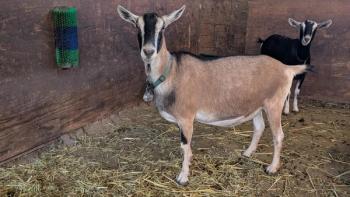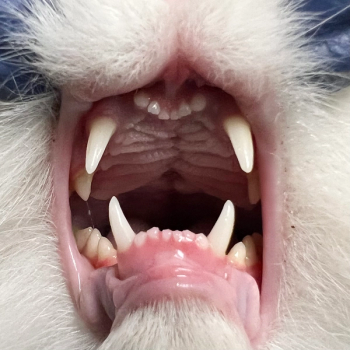
Evaluating hindlimb lameness in juvenile dogs
Get affected dogs back comfortably on all fours by examining these most common causes and how they can be treated.
As discussed in Part 1, panosteitis and hypertrophic osteodystrophy can cause acute discomfort and lameness in the long bones of young dogs. However, both of these conditions tend to be self-limiting. Therefore, neither should be considered as the sole cause in a more persistent lameness. See Table 1 for an overview of assessing juvenile dogs exhibiting forelimb lameness.
Osteochondritis dissecans
Hindlimb lameness localized to the tarsal joint is most commonly caused by osteochondritis dissecans (OCD). Tarsal OCD has the same pathogenesis as OCD in general and most commonly affects large breeds (e.g., rottweilers, Labrador retrievers) younger than 1 year of age.
Table 1: Keys to identifying the cause of lameness in juvenile dogs
The clinical signs of tarsal OCD include lameness, joint effusion, medial thickening, crepitus, hyperextension with decreased flexion of the tarsocrural joint and pain on palpation.
Radiographs demonstrate the typical tarsal OCD lesion on the medial condyle of the talus and concurrent osteoarthritic changes (Photo 1).
Photo 1: A craniocaudal view of the tarsus demonstrating an OCD lesion on the medial aspect of the talus, resulting in the appearance of an increased joint space.
Treatment includes débridement of the free osteochondral fragment and underlying subchondral bone via an open arthrotomy. The joint space of the talocrural joint is generally too small even in large dogs to allow arthroscopic treatment.
The prognosis depends on the degree of arthritis present, but dogs often have continued progression of degenerative changes, thickened tarsi and intermittent lameness.
Photo 2: A craniocaudal view of a stifle with a large OCD lesion on the medial aspect of the lateral femoral condyle.
OCD can also affect the stifle joint, with radiographic changes noted as a flattening or divot on the medial aspect of the lateral femoral condyle (Photo 2). (Caution: Don't confuse the fossa of the long digital extensor tendon for an OCD lesion.) Often, disruption of the patellar fat pad by effusion is also noted.
Stifle OCD results in lameness, a crouched stance, muscle atrophy, joint effusion, discomfort and, sometimes, an audible click with range of motion. These stifles are stable.
Treatment is the same as noted previously for OCD. After surgical treatment, dogs will improve clinically; however, they will have arthritic changes over time.
Medial patellar luxation
A congenital condition commonly seen in young, toy-breed dogs, medial patellar luxation (MPL) is characterized by medial displacement of the patella out of the trochlear groove. Conformational changes resulting in MPL include:
- Lateral femoral bowing
- Distal femoral varus
- Lateral torsion of the distal femur
- Medial displacement of tibial tuberosity
- Medial bowing of the proximal tibia
- Lateral torsion of the distal tibia.
These conditions lead to signs that include intermittent lameness and gait change.
Dogs with MPL are often not in pain. Pomeranians, Yorkshire terriers, Boston terriers and poodles are commonly affected. In the past, we thought MPL was most common in toy breeds, while lateral patellar luxation was most common in larger breeds, and if we did encounter MPL in a large breed, it was more likely caused by trauma and less likely to be congenital. But we now recognize congenital MPL in some larger breeds as well, such as Labrador retrievers, Chow Chows and Staffordshire terriers.
Photo 3: A craniocaudal view of a stifle with MPL. Note the displaced patella and the torsional deformity of the tibia.
MPL is diagnosed based on clinical signs and orthopedic examination results—less commonly on a radiographic examination. (To give a full evaluation using radiographs, a craniocaudal radiograph should ideally contain the hip femur, stifle, tibia and hock in a single view.) The patella may be reduced at the time of the image; however, other conformational changes contributing to the MPL are usually still evident (Photo 3).
Surgical correction of MPL is recommended and usually involves all or a combination of the following: trochlear wedge/block recession, tibial crest transposition, medial capsular release and lateral capsular imbrication. Severe, grade IV MPLs with marked limb deformity typically require corrective femoral or tibial osteotomies, or both. Grade I, II and III MPLs treated appropriately have a good prognosis for return to function and resolution or lessening the grade of luxation.
Cranial cruciate injury
Cranial cruciate injury is the single most common orthopedic injury seen in dogs. Fortunately, it's not as common in juvenile dogs, but it should remain on the differential diagnosis list for dogs demonstrating hindlimb lameness localized to the stifle, particularly when effusion and instability are noted.
Hip dysplasia
Lameness localized to the coxofemoral joint in large and giant breeds (e.g., Newfoundlands, Great Pyrenees, German shepherds, mastiffs, Labrador and golden retrievers) and chondrodystrophic breeds (e.g., bulldogs, Shih Tzus and corgis) is most commonly attributed to coxofemoral dysplasia. Hip dysplasia is abnormal development and growth of the coxofemoral joint resulting in abnormal laxity and incongruity of the joint. It's a polygenic, heritable condition significantly influenced by environmental factors. Hip dysplasia and incongruity leads to laxity and subluxation of the coxofemoral joint, resulting in cartilage damage, followed by progressive degenerative changes and osteoarthritis.
Photo 4A: A standard ventrodorsal hip-extended OFA view of the pelvis demonstrating bilateral coxofemoral subluxation and early degenerative changes.
Hip dysplasia is considered a biphasic disease, with dogs demonstrating signs at two stages of life. Signs generally include:
- Bunny-hopping gait
- Reluctance to climb stairs, jump or exercise
- Stiffness after rest
- Poor hindlimb musculature
- Popping or clicking sound when sitting or rising.
Signs of hip dysplasia in juvenile dogs are due to hip laxity, subluxation of the femoral head, joint inflammation, effusion and pain. Signs in adults are from decreased range of motion, cartilage loss and remodeling, osteoarthritis, joint inflammation and pain.
Photo 4B: A standard PennHIP compression view of the pelvis.
In juvenile dogs, positive Ortolani or Barden signs are consistent with joint laxity and subluxation. Radiographs (OFA hip extended and PennHIP views) of the pelvis can confirm the diagnosis (Photos 4A-4C).
Conservative treatment of hip dysplasia includes weight control, low-impact exercise, nonsteroidal anti-inflammatory agents, analgesics and chondroprotectives. Successful surgical treatments depend on an animal's age and degree of arthritis; a full explanation is beyond the scope of this article.*
Photo 4C: A standard PennHIP distraction view of the pelvis.
Legg-Calvé-Perthes disease
This condition should be considered when lameness is localized to the coxofemoral joint in small breeds, especially toy breeds and terriers. The pathophysiology of Legg-Calvé-Perthes disease (LCP) is not completely known, but it is characterized by ischemic damage to the femoral head and neck resulting from vascular compression. Normal weight-bearing activities then cause compression and malformation of the head and neck.
An autosomal recessive gene linked to LCP has been identified. Clinical signs of LCP include hindlimb lameness, pain with manipulation of the coxofemoral joint and muscle atrophy. Diagnosis is based on signalment, clinical signs and radiographs (Photo 5). The treatment of choice is femoral head ostectomy.
Photo 5: A ventrodorsal view of the pelvis demonstrating Legg-Calvé-Perthes. Note the apple core appearance and irregularity of the right femoral head and neck.
Conclusion
Lameness in juvenile canines can have myriad causes but most commonly can be attributed to the conditions discussed in this two-part article series. Remember: The key to diagnosis of lameness is localization.
*For more on this topic, see: Henry WB.
Dr. Janice Buback is a surgeon with Lakeshore Veterinary Specialists in Port Washington, Glendale and Oak Creek, Wis.
Newsletter
From exam room tips to practice management insights, get trusted veterinary news delivered straight to your inbox—subscribe to dvm360.






